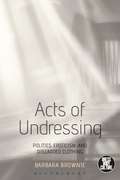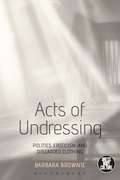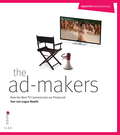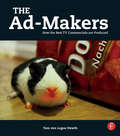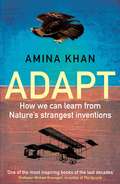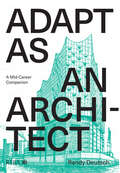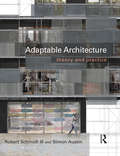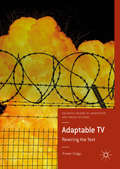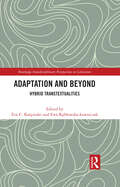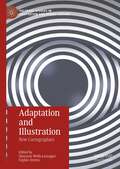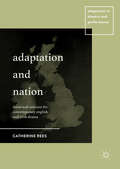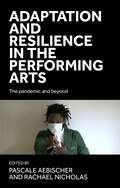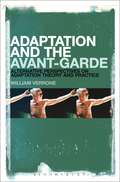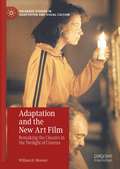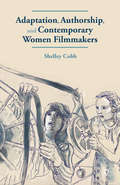- Table View
- List View
Acts of Undressing: Politics, Eroticism, and Discarded Clothing (Dress, Body, Culture)
by Barbara BrownieThe act of undressing has a multitude of meanings, which vary dramatically when this commonly private gesture is presented for public consumption. This ground-breaking book explores the significance of undressing in various cultural and social contexts.As we are increasingly obsessed with dress choices as signifiers of who we are and how we feel, an investigation into what happens as we remove our clothes has never been more pertinent. Exploring three main issues - politics, tease, and clothes without bodies - Acts of Undressing discusses these key themes through an in-depth and eclectic mix of case studies including flashing at Mardi Gras, the World Burlesque Games, and 'shoefiti' used by gangs to mark territories.Building on leading theories of dress and the body, from academics including Roland Barthes and Mario Perniolato, Ruth Barcan and Erving Goffman, Acts of Undressing is essential reading for students of fashion, sociology, anthropology, visual culture, and related subjects.
Acts of Undressing: Politics, Eroticism, and Discarded Clothing (Dress, Body, Culture)
by Barbara BrownieThe act of undressing has a multitude of meanings, which vary dramatically when this commonly private gesture is presented for public consumption. This ground-breaking book explores the significance of undressing in various cultural and social contexts.As we are increasingly obsessed with dress choices as signifiers of who we are and how we feel, an investigation into what happens as we remove our clothes has never been more pertinent. Exploring three main issues - politics, tease, and clothes without bodies - Acts of Undressing discusses these key themes through an in-depth and eclectic mix of case studies including flashing at Mardi Gras, the World Burlesque Games, and 'shoefiti' used by gangs to mark territories.Building on leading theories of dress and the body, from academics including Roland Barthes and Mario Perniolato, Ruth Barcan and Erving Goffman, Acts of Undressing is essential reading for students of fashion, sociology, anthropology, visual culture, and related subjects.
The Ad Makers: How the Best TV Commercials are Produced (Creative Professional Ser.)
by Tom von NewthThe Ad-Makers looks at the cinematic form where commerce and creativity collide most dramatically: the TV commercial.Featuring interviews from top professionals in the field, the book provides the kind of behind-the-scenes expertise that it usually takes a lifetime of professional practice to acquire.Gathered from the disciplines of cinematography, directing, producing and editing, the filmmakers tell the stories behind the making of some of the world's top commercials. Each chapter includes an overview of best practice and a host of images-stills from the spots themselves and concept visuals.Exploring the creative process from conception to post-production, The Ad-Makers also covers developments within the industry precipitated by the digital age and the new challenges placed on ad-making by the explosion of social media.With special focus on the shooting and production elements of making a television advert, this book is ideal for all filmmakers who want to build a career in advertising, or, as is increasingly common, feature films.- The stories behind some of the best-known TV commercials, as told by the people who made them- Top producers, designers, storyboarders, directors, editors and visual effects creatives reveal the secrets of the television advertising industry
The Ad-Makers: How the Best TV Commercials are Produced (Creative Professional Ser.)
by Tom von Logue NewthThe Ad-Makers looks at the cinematic form where commerce and creativity collide most dramatically: the TV commercial. Featuring interviews from top professionals in the field, the book provides the kind of behind-the-scenes expertise that it usually takes a lifetime of professional practice to acquire. Gathered from the disciplines of cinematography, directing, producing, and editing, the filmmakers tell the stories behind the making of some of the world’s top commercials. Each chapter includes an overview of best practice and a host of images—stills from the spots themselves and concept visuals. Exploring the creative process from conception to post-production, The Ad-Makers also covers developments within the industry precipitated by the digital age and the new challenges placed on ad-making by the explosion of social media. With special focus on the shooting and production elements of making a television advert, this book is ideal for all filmmakers who want to build a career in advertising or even feature films. • The stories behind some of the best-known TV commercials, as told by the people who made them • Top producers, designers, storyboarders, directors, editors, and visual effects creatives reveal the secrets of the television advertising industry
The Ad-Makers: How the Best TV Commercials are Produced
by Tom von Logue NewthThe Ad-Makers looks at the cinematic form where commerce and creativity collide most dramatically: the TV commercial. Featuring interviews from top professionals in the field, the book provides the kind of behind-the-scenes expertise that it usually takes a lifetime of professional practice to acquire. Gathered from the disciplines of cinematography, directing, producing, and editing, the filmmakers tell the stories behind the making of some of the world’s top commercials. Each chapter includes an overview of best practice and a host of images—stills from the spots themselves and concept visuals. Exploring the creative process from conception to post-production, The Ad-Makers also covers developments within the industry precipitated by the digital age and the new challenges placed on ad-making by the explosion of social media. With special focus on the shooting and production elements of making a television advert, this book is ideal for all filmmakers who want to build a career in advertising or even feature films. • The stories behind some of the best-known TV commercials, as told by the people who made them • Top producers, designers, storyboarders, directors, editors, and visual effects creatives reveal the secrets of the television advertising industry
An Adams fireplace (large print)
by RnibThis is an image of a fireplace shown from the front. There is a locator dot shown, which will be at the top left of the page when the image is the correct way up. At the top of the image there is the wooden mantelpiece going horizontally from left to right. It is made of four layers, each decreasing in size down the page. Down from this is the horizontal section of the fireplace. It is also made from wood and the central panel has paler decorative woodcarvings stuck on. In the middle is a large goblet with a leaf shape design going to the left and right. These lead to the left and right to a heart shape, a ribbon that curves down and up and a second heart. Down from this to the far left and right are the wooden up-stands of the fireplace. There is an off-centred column on each. These are proud of the tall rectangular back panel. To the right of the left up-stand, to the left of the right up-stand and down from the horizontal section of the fireplace is a thin decorative trim in a paler wood that frames the rest of the fireplace. To the right of the left vertical trim and the left of the right vertical trim are four wall tiles on each side. These would have delicate and intricate ceramic designs and patterns on them, which are not shown. At the bottom centre of the image is the grate pan holding back the ashes of the fire. In the middle is a handle to withdraw the pan. Up from this is the grate griddle holding back the coals of the fire. Up the page is the space where the fire would burn, and up again is the smoke shoot that directs the smoke up the chimney.
An Adams fireplace (UEB contracted)
by RnibThis is an image of a fireplace shown from the front. There is a locator dot shown, which will be at the top left of the page when the image is the correct way up. At the top of the image there is the wooden mantelpiece going horizontally from left to right. It is made of four layers, each decreasing in size down the page. Down from this is the horizontal section of the fireplace. It is also made from wood and the central panel has paler decorative woodcarvings stuck on. In the middle is a large goblet with a leaf shape design going to the left and right. These lead to the left and right to a heart shape, a ribbon that curves down and up and a second heart. Down from this to the far left and right are the wooden up-stands of the fireplace. There is an off-centred column on each. These are proud of the tall rectangular back panel. To the right of the left up-stand, to the left of the right up-stand and down from the horizontal section of the fireplace is a thin decorative trim in a paler wood that frames the rest of the fireplace. To the right of the left vertical trim and the left of the right vertical trim are four wall tiles on each side. These would have delicate and intricate ceramic designs and patterns on them, which are not shown. At the bottom centre of the image is the grate pan holding back the ashes of the fire. In the middle is a handle to withdraw the pan. Up from this is the grate griddle holding back the coals of the fire. Up the page is the space where the fire would burn, and up again is the smoke shoot that directs the smoke up the chimney.
An Adams fireplace (UEB uncontracted)
by RnibThis is an image of a fireplace shown from the front. There is a locator dot shown, which will be at the top left of the page when the image is the correct way up. At the top of the image there is the wooden mantelpiece going horizontally from left to right. It is made of four layers, each decreasing in size down the page. Down from this is the horizontal section of the fireplace. It is also made from wood and the central panel has paler decorative woodcarvings stuck on. In the middle is a large goblet with a leaf shape design going to the left and right. These lead to the left and right to a heart shape, a ribbon that curves down and up and a second heart. Down from this to the far left and right are the wooden up-stands of the fireplace. There is an off-centred column on each. These are proud of the tall rectangular back panel. To the right of the left up-stand, to the left of the right up-stand and down from the horizontal section of the fireplace is a thin decorative trim in a paler wood that frames the rest of the fireplace. To the right of the left vertical trim and the left of the right vertical trim are four wall tiles on each side. These would have delicate and intricate ceramic designs and patterns on them, which are not shown. At the bottom centre of the image is the grate pan holding back the ashes of the fire. In the middle is a handle to withdraw the pan. Up from this is the grate griddle holding back the coals of the fire. Up the page is the space where the fire would burn, and up again is the smoke shoot that directs the smoke up the chimney.
Adapt: How We Can Learn from Nature's Strangest Inventions
by Amina KhanNature's creations are more sophisticated and elegant than anything humans have created. Geckos can run upside down along ceilings. Termite mounds can stay cool in the desert without air conditioning. Adapt explores how we can harness such ideas through the ground-breaking new science of biomimicry - which looks to nature to solve pressing problems in engineering and science. From the depths of the oceans to the ice sheets of the Arctic, Amina Khan talks to the researchers at the forefront of this exciting new science, who are designing everything from wind turbines to military camouflage. An entertaining eulogy to the power of evolution, this captivating book is a must read for anyone with an interest in design, nature and technology.Khan leaves no stone unturned... Readers will leave this book with a buzzing excitement. - BBC Wildlife
Adapt As An Architect: A Mid-Career Companion
by Randy DeutschAdapt As An Architect: A Mid-Career Companion is the only book that helps design professionals to navigate the vast heart of the architect’s journey. It serves as a roadmap: a career GPS that provides options for architects getting from where they are today to where they really want to be. The focus of this optimistic, engaging book is on continued relevance, professional engagement, perseverance, and career longevity. It argues that mid-career is the lynchpin of the architect’s career, and provides the guidance and support that practices themselves are missing for emerging professionals, who are often left to their own devices to find their way as they approach the middle of their career. This book means architects don’t need to navigate these years on their own.
Adapt As An Architect: A Mid-Career Companion
by Randy DeutschAdapt As An Architect: A Mid-Career Companion is the only book that helps design professionals to navigate the vast heart of the architect’s journey. It serves as a roadmap: a career GPS that provides options for architects getting from where they are today to where they really want to be. The focus of this optimistic, engaging book is on continued relevance, professional engagement, perseverance, and career longevity. It argues that mid-career is the lynchpin of the architect’s career, and provides the guidance and support that practices themselves are missing for emerging professionals, who are often left to their own devices to find their way as they approach the middle of their career. This book means architects don’t need to navigate these years on their own.
Adaptable Architecture: Theory and practice
by Robert Schmidt III Simon AustinAdaptable Architecture provides thought-provoking and inquisitive insights into how we can prolong the useful life of buildings by designing them to be more adaptable, and hence create a more sustainable built environment. The book provides a theoretical foundation counterpointed by the experiences and ideas of those involved in the design and use of buildings. It explains many approaches to designing for change, with lessons from history, and case studies including The Cedar Rapids Public Library, Kentish Town Health Centre and Folkestone Performing Arts Centre, which stretch our thinking beyond the conventional notions of adaptability. The authors reveal the many conditions that make it a complex design phenomenon, by considering the purpose, design and business case of buildings as well as the physical product. Full of summaries, diagrams, reference charts, tables, and photos of exemplar solutions for use as conversational tools or working aids, this book is for any professional or student who wants to research, question, imagine, illustrate - and ultimately design for - adaptation. In addition, further information and resources are available through the Adaptable Futures website www.adaptablefutures.com which includes additional case studies, videos, information about industry events and up-to-the-minute developments.
Adaptable Architecture: Theory and practice
by Robert Schmidt III Simon AustinAdaptable Architecture provides thought-provoking and inquisitive insights into how we can prolong the useful life of buildings by designing them to be more adaptable, and hence create a more sustainable built environment. The book provides a theoretical foundation counterpointed by the experiences and ideas of those involved in the design and use of buildings. It explains many approaches to designing for change, with lessons from history, and case studies including The Cedar Rapids Public Library, Kentish Town Health Centre and Folkestone Performing Arts Centre, which stretch our thinking beyond the conventional notions of adaptability. The authors reveal the many conditions that make it a complex design phenomenon, by considering the purpose, design and business case of buildings as well as the physical product. Full of summaries, diagrams, reference charts, tables, and photos of exemplar solutions for use as conversational tools or working aids, this book is for any professional or student who wants to research, question, imagine, illustrate - and ultimately design for - adaptation. In addition, further information and resources are available through the Adaptable Futures website www.adaptablefutures.com which includes additional case studies, videos, information about industry events and up-to-the-minute developments.
Adaptable TV: Rewiring the Text (Palgrave Studies in Adaptation and Visual Culture)
by Yvonne GriggsThis book focuses on the significantly under-explored relationship between televisual culture and adaptation studies in what is now commonly regarded as the ‘Golden Age’ of contemporary TV drama. Adaptable TV: Rewiring the Text does not simply concentrate on traditional types of adaptation, such as reboots, remakes and sequels, but broadens the scope of enquiry to examine a diverse range of experimental adaptive types that are emerging within an ever-changing TV landscape. With a particular focus on the serial narrative form, and with case studies that include Penny Dreadful, Fargo, The Night Of and Orange is the New Black, this study is essential reading for anyone who is interested in the complex interplay between television studies and adaptation studies.
Adaptable TV: Rewiring the Text (Palgrave Studies in Adaptation and Visual Culture)
by Yvonne GriggsThis book focuses on the significantly under-explored relationship between televisual culture and adaptation studies in what is now commonly regarded as the ‘Golden Age’ of contemporary TV drama. Adaptable TV: Rewiring the Text does not simply concentrate on traditional types of adaptation, such as reboots, remakes and sequels, but broadens the scope of enquiry to examine a diverse range of experimental adaptive types that are emerging within an ever-changing TV landscape. With a particular focus on the serial narrative form, and with case studies that include Penny Dreadful, Fargo, The Night Of and Orange is the New Black, this study is essential reading for anyone who is interested in the complex interplay between television studies and adaptation studies.
Adaptation and Beyond: Hybrid Transtextualities (Routledge Interdisciplinary Perspectives on Literature)
by Eva C. Karpinski Ewa Kębłowska-ŁawniczakThis interdisciplinary collection focuses on recent adaptations, both experimental and popular, that put hybridity, transtextuality, and transmediality at play. It reframes adaptation in terms of the transmedia concept of "world-building," which accurately captures the complexity and multidirectionality of contemporary scattered and ubiquitous practices of adaptation. The Editors argue that the process of moving stories or their elements across different media platforms and repurposing them for new uses results in the production of hybrid transtextualities. The book demonstrate how hybrid textualities augment narrative and literary forms as goals of their world-building, finding unexpected sites of cross-pollination, expansion, and appropriation in spoken-word and dance performance, (auto)biographical comics, advertising, Chinese Kun opera, and popular song lyrics. This yoking of hybridity and transmediality yields not only diversified and often commercialized aesthetic forms but also enables the emergence a unique cultural space in-between, a mezzaterra capable of addressing current political issues and mobilizing broader audiences
Adaptation and Beyond: Hybrid Transtextualities (Routledge Interdisciplinary Perspectives on Literature)
This interdisciplinary collection focuses on recent adaptations, both experimental and popular, that put hybridity, transtextuality, and transmediality at play. It reframes adaptation in terms of the transmedia concept of "world-building," which accurately captures the complexity and multidirectionality of contemporary scattered and ubiquitous practices of adaptation. The Editors argue that the process of moving stories or their elements across different media platforms and repurposing them for new uses results in the production of hybrid transtextualities. The book demonstrate how hybrid textualities augment narrative and literary forms as goals of their world-building, finding unexpected sites of cross-pollination, expansion, and appropriation in spoken-word and dance performance, (auto)biographical comics, advertising, Chinese Kun opera, and popular song lyrics. This yoking of hybridity and transmediality yields not only diversified and often commercialized aesthetic forms but also enables the emergence a unique cultural space in-between, a mezzaterra capable of addressing current political issues and mobilizing broader audiences
Adaptation and Illustration: New Cartographies (Palgrave Studies in Adaptation and Visual Culture)
by Shannon Wells-Lassagne Sophie AymesThis collection examines the relationship between illustration and adaptation from an intermedial and transcultural perspective. It aims to foster a dialogue between two fields that co-exist without necessarily acknowledging advances in each other’s domains, providing an argument for defining illustration as a form of adaptation, as well as an intermedial practice that redefines what we mean by adaptation. The volume embraces both a specific and an extended definition of illustration that accounts for its inclusion among the web of adaptive practices that developed with the rise of new media and intermediality. The contributors explore how crossovers may contribute to reappraise their objects, and rely on a transmedial and interdisciplinary corpus exploring the boundaries between illustration and other media such as texts, graphic novels, comics, theatre, film and mobile applications. Arguably adaptation, like intermediality, is an umbrella term that covers a variety of practices and products, and both of them have been shaped by intense debates over their boundaries and internal definitions. Illustration belongs to each of these areas, and this volume proposes insight into how illustration not only relates to adaptation and intermediality but how each field is redefined, enriched and also challenged by such interactions.
Adaptation and Nation: Theatrical Contexts for Contemporary English and Irish Drama (Adaptation in Theatre and Performance)
by Catherine ReesThis book focuses on modern theatrical adaptations that rework classic plays in new British and Irish settings. It explores these shifted national contexts and examines what they might reveal about the political and cultural climate of the new setting. In examining the modern setting alongside the country of the original text, it also reveals fascinating resonances between two different national contexts. The book discusses five British and Irish playwrights and their current adaptations, examining well-known dramatists such as Martin McDonagh, Sarah Kane and Brian Friel, while analysing some of their less well-known plays, offering a novel examination of the adaptation process. The book further provides an insightful commentary on some significant events of the twentieth century in Britain and Ireland, such as the historic Labour victory of 1945 and scandals in the Royal Family since the 1990s. This book will appeal to theatre and performance enthusiasts, as well as students and scholars of both theatre and adaptation.
Adaptation and resilience in the performing arts: The pandemic and beyond (The pandemic and beyond)
by Pascale Aebischer Rachael NicholasThis book offers insights into some of the digital innovations, structural adaptations and analogue solutions that enabled live performance in the UK to survive through the COVID-19 pandemic. It provides evidence of values-led policies and practices that have improved the wellbeing of the creative workforce and have increased access to live performance. Through sections that address digital innovations, workforce resilience and programming live performances outdoors and in community settings, this book provides practical insights into the challenges live performance faced during the pandemic. It shows how, in order to survive, individuals and companies within the sector drew on the creativity and resourcefulness of its workforce, and on new and existing networks. In these accounts, the pandemic functioned as catalyst for technological innovations, stock-taking regarding exploitative industry structures, and a re-valuing of the role of live performance for community-building.
Adaptation and resilience in the performing arts: The pandemic and beyond (The pandemic and beyond)
by Pascale Aebischer and Rachael NicholasThis book offers insights into some of the digital innovations, structural adaptations and analogue solutions that enabled live performance in the UK to survive through the COVID-19 pandemic. It provides evidence of values-led policies and practices that have improved the wellbeing of the creative workforce and have increased access to live performance. Through sections that address digital innovations, workforce resilience and programming live performances outdoors and in community settings, this book provides practical insights into the challenges live performance faced during the pandemic. It shows how, in order to survive, individuals and companies within the sector drew on the creativity and resourcefulness of its workforce, and on new and existing networks. In these accounts, the pandemic functioned as catalyst for technological innovations, stock-taking regarding exploitative industry structures, and a re-valuing of the role of live performance for community-building.
Adaptation and the Avant-Garde: Alternative Perspectives on Adaptation Theory and Practice
by William VerroneAdaptations have occurred regularly since the beginning of cinema, but little recognition has been given to avant-garde adaptations of literary or other texts. This compelling study corrects such omissions by detailing the theory and practice of alternative adaptation practices from major avant-garde directors. Avant-Garde films are often relegated to the margins because they challenge our traditional notions of what film form and style can accomplish. Directors who choose to adapt previous material run the risk of severe critical dismay; making films that are highly subjective interpretations or representations of existing texts takes courage and foresight. An avant-garde adaptation provokes spectators by making them re-think what they know about film itself, just as much as the previous source material.Adaptation and the Avant-Garde examines films by Peter Greenaway, Jean-Luc Godard, Guy Maddin, Jan Svankmajer and many others, offering illuminating insights and making us reconsider the nature of adaptation, appropriation, borrowing, and the re-imagining of previous sources.
Adaptation and the Avant-Garde: Alternative Perspectives on Adaptation Theory and Practice
by William VerroneAdaptations have occurred regularly since the beginning of cinema, but little recognition has been given to avant-garde adaptations of literary or other texts. This compelling study corrects such omissions by detailing the theory and practice of alternative adaptation practices from major avant-garde directors. Avant-Garde films are often relegated to the margins because they challenge our traditional notions of what film form and style can accomplish. Directors who choose to adapt previous material run the risk of severe critical dismay; making films that are highly subjective interpretations or representations of existing texts takes courage and foresight. An avant-garde adaptation provokes spectators by making them re-think what they know about film itself, just as much as the previous source material.Adaptation and the Avant-Garde examines films by Peter Greenaway, Jean-Luc Godard, Guy Maddin, Jan Svankmajer and many others, offering illuminating insights and making us reconsider the nature of adaptation, appropriation, borrowing, and the re-imagining of previous sources.
Adaptation and the New Art Film: Remaking the Classics in the Twilight of Cinema (Palgrave Studies in Adaptation and Visual Culture)
by William H. MooneySince the 1990s, the expropriation of canonical works of cinema has been a fundamental dimension of art-film exploration. Rainer Werner Fassbinder provides an early model of open adaptation of film classics, followed ever more boldly by the Coen Brothers, Chantal Akerman, Alex Carax, Todd Haynes, Florian Henckel von Donnersmarck, Baz Luhrmann, and Olivier Assayas. This book devotes chapters to each of these directors to examine how their films redeploy landmark precursors such as City Lights (1931), Citizen Kane (1941), Rome Open City (1945), All About Eve (1950), and Vertigo (1958) in order to probe our psychological, philosophical, and historical situations in a postmodern société du spectacle. In broadly diverse ways, each of these directors complicates received notions of the past and its representation, while probing the transformative media evolution and dislocation of the present, in film art and in society.
Adaptation, Authorship, and Contemporary Women Filmmakers
by S. CobbA lively discussion of costume dramas to women's films, Shelley Cobb investigates the practice of adaptation in contemporary films made by women. The figure of the woman author comes to the fore as a key site for the representation of women's agency and the authority of the woman filmmaker.
